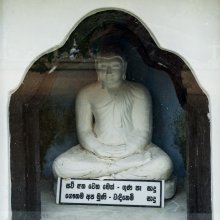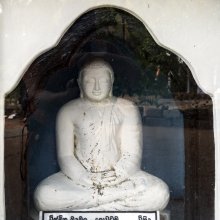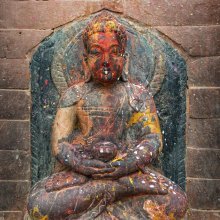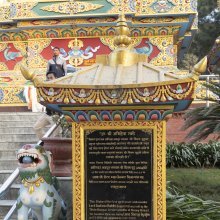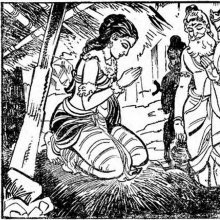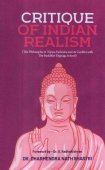Gautama, Gauṭama: 33 definitions
Introduction:
Gautama means something in Buddhism, Pali, Hinduism, Sanskrit, Jainism, Prakrit. If you want to know the exact meaning, history, etymology or English translation of this term then check out the descriptions on this page. Add your comment or reference to a book if you want to contribute to this summary article.
Images (photo gallery)
(+33 more images available)
In Hinduism
Purana and Itihasa (epic history)
Source: Wisdom Library: Bhagavata PuranaGautama (गौतम):—Husband of Ahalyā (Female counterpart of the twin children of Mudgala). They had a son named Śatānanda. (see Bhāgavata Purāṇa 9.21.34)
Source: archive.org: Puranic Encyclopedia1) Gautama (गौतम).—General Information The Purāṇas record about a sage called Gautama though nothing is known about his genealogy. Yet the genealogy of his wife Ahalyā is available. See under 'Ahalyā'. (See full article at Story of Gautama from the Puranic encyclopaedia by Vettam Mani)
2) Gautama (गौतम).—A brahmin who was a member of the court of Yudhiṣṭhira. He was a member of Indrasabhā also. This Gautama while he was living in Girivraja had sexual relations with a Śūdra woman from the country of Uśīnara and a son was born to them named Kakṣivān. (Ślokas 17, 18 and 3 of Chapters 4, 7 and 21 respectively of Sabhā Parva, Mahābhārata).
3) Gautama (गौतम).—An ascetic of great erudition. He had three sons named Ekata, Dvita and Trita. (See under 'Ekata'). (Śloka 79, Chapter 36, Śalya Parva).
4) Gautama (गौतम).—Another ascetic of great virtue. Once when this Gautama was going through the forest he saw an elephant babe lying wearied. He took it to his āśrama and brought it up. When it became a full grown elephant Indra disguised as the emperor Dhṛtarāṣṭra came to take it away secretly. Gautama found it out and then he was offered thousand cows and much wealth in lieu of the elephant. But Gautama refused to part with the elephant. Pleased with his extreme affection for his dependant, Indra took both Gautama and the elephant to heaven. (Chapter 102, Anuśāsana Parva).
5) Gautama (गौतम).—An ungrateful brahmin. He was born in Madhyadeśa. He left his parents and after travelling in many lands he came to a country of foresters. The foresters received him with respect and he lived in a hut of the foresters and married a lady from among them.
Gautama abandoned his brahminhood and accepted the duties of foresters. He was living like this when another brahmin boy came to that village. He searched in vain for a brahmin house to stay for the night and then knowing that a man born a brahmin but made a forester by his duties was living there he went to his house. Gautama also came there carrying the animals and birds he had hunted down that day. His body was bathed in blood. The brahmin guest felt compassion for Gautama and advised him to leave his trade and go to his house in his country.
Source: archive.org: Shiva Purana - English TranslationGautama (गौतम) is the name of a Sage (Muni) who once attended a great sacrifice by Dakṣa, according to the Śivapurāṇa 2.2.27. Accordingly as Brahmā narrated to Nārada:—“[...] once a great sacrifice was started by Dakṣa, O sage. To partake in that sacrifice, the celestial and terrestrial sages and devas were invited by Śiva and they reached the place being deluded by Śiva’s Māyā. [Gautama, ...] and many others along with their sons and wives arrived at the sacrifice of Dakṣa—my son”.
Source: Cologne Digital Sanskrit Dictionaries: The Purana Index1a) Gautama (गौतम).—Came to see Bhiṣma in his death-bed and called on Parīkṣit engaged in Prāyopaveśa.*
- * Bhāgavata-purāṇa I. 9. 7; 10. 9; 19. 10.
1b) A siddha; his wife was Ahalyā and son Śatānanda (Gotama, Brahmāṇḍa-purāṇa); cursed Indra.*
- * Bhāgavata-purāṇa IX. 21. 34; Brahmāṇḍa-purāṇa II. 27. 23.
1c) A sage of the Vaivasvata epoch; present at Ambarīṣa's aśvamedha.*
- * Bhāgavata-purāṇa VIII. 13. 5; IX. 4. 22; Matsya-purāṇa 9. 27.
1d) A name of Kṛpa—invited for Yudhiṣṭhira's rājasūya. Came to Syamantapañcaka to see Kṛṣṇa on the occasion of a solar eclipse.*
- * Bhāgavata-purāṇa X. 49. 2; 74. 7; 84. 3.
1e) The sage who presides over the month tapas.*
- * Bhāgavata-purāṇa XII. 11. 39; Brahmāṇḍa-purāṇa II. 23. 12. Viṣṇu-purāṇa 52. 12; 61. 44.
1f) A son of Utathya; also known as Śaradvat; a pupil of Kṛta.*
- * Brahmāṇḍa-purāṇa II. 35. 52; 38. 28.
1g) The 20th Vedavyāsa.*
- * Brahmāṇḍa-purāṇa II. 35. 121; Viṣṇu-purāṇa I. 9. 21; III. 1. 32; 3. 16.
1h) Officiated at Paraśurāma's sacrifice;1 āśrama near the town Jayanta;2 after him was named a forest region.3
- 1) Brahmāṇḍa-purāṇa III. 36. 5; 47. 48.
- 2) Brahmāṇḍa-purāṇa III. 64. 2; Vāyu-purāṇa 59. 2.
- 3) Vāyu-purāṇa 23. 163.
1i) Originally Dīrghatamas, became Gautama rid of the curse of Bṛhaspati by Surabhi's favour. Heard the vāyu purāṇa from Bharadvāja and narrated it to Nīryantra.*
- * Brahmāṇḍa-purāṇa III. 74. 94. IV. 4. 63. Vāyu-purāṇa 99. 92; 103. 63; 106. 38.
1j) The avatār of the Lord in the 14th dvāpara of the family of Angiras in the Gautamavana with four sons at the end of the yuga.*
- * Vāyu-purāṇa 23. 163.
1k) A son of Uśija and brother of Dīrghatamas, (s.v.) Praised Tripurāri.*
- * Matsya-purāṇa 48. 53; 126. 13; 133. 67.
1l) A mind-born son of Brahmā.*
- * Matsya-purāṇa 171. 27; 192. 10.
1m) A son of Surūpā and a gotrakara.*
- * Matsya-purāṇa 196. 4-5.
1n) (Śaradvat) a son of Angiras by Svarāṭ.*
- * Vāyu-purāṇa 64. 26; 65. 97 and 100.
1o) In the sun's chariot in the month of Āśvayuja.*
- * Viṣṇu-purāṇa II. 10. 11.
1p) Officiated as hota in Nimi's sacrifice.*
- * Viṣṇu-purāṇa IV. 5. 6.
1q) A collective name of the sons of Kākṣīvat.*
- * Matsya-purāṇa 48. 88.
1r) A clan of Angirasas.*
- * Vāyu-purāṇa 65. 97.
Gautama (गौतम) is the name of one of the seven sages (saptarṣi) in the Vaivasvatamanvantara: one of the fourteen Manvantaras, according to the 10th century Saurapurāṇa: one of the various Upapurāṇas depicting Śaivism.—Accordingly, “The present, the seventh manvantara is Vaivasvata [viz., vaivasvatamanvantara]. In this manvantara, Purandara is the Indra who is the Subduer of the pride of the Asuras; The gods are the Ādityas, the Rudras, the Vasus and the Maruts. The seven seers are Vasiṣṭha, Kaśyapa, Atri, Jamadagni, Gautama, Viśvāmitra and Bharadvāja.”.

The Purana (पुराण, purāṇas) refers to Sanskrit literature preserving ancient India’s vast cultural history, including historical legends, religious ceremonies, various arts and sciences. The eighteen mahapuranas total over 400,000 shlokas (metrical couplets) and date to at least several centuries BCE.
Natyashastra (theatrics and dramaturgy)
Source: Wisdom Library: Nāṭya-śāstra1) Gautama (गौतम) is the Sanskrit name of one of Bharata’s sons, mentioned in the Nāṭyaśāstra 1.26-33. After Brahmā created the Nāṭyaveda (nāṭyaśāstra), he ordered Bharata to teach the science to his (one hundred) sons. Bharata thus learned the Nāṭyaveda from Brahmā, and then made his sons study and learn its proper application. After their study, Bharata assigned his sons (eg., Gautama) various roles suitable to them.
2) Gautama (गौतम) is the name of a sage who was in the company of Bharata when he recited the Nāṭyaveda them, according to the Nāṭyaśāstra chapter 35. Accordingly, they asked the following questions, “O the best Brahmin (lit. the bull of the twice-born), tell us about the character of the god who appears in the Preliminaries (pūrvaraṅga). Why is the sound [of musical instruments] applied there? What purpose does it serve when applied? What god is pleased with this, and what does he do on being pleased? Why does the Director being himself clean, perform ablution again on the stage? How, O sir, the drama has come (lit. dropped) down to the earth from heaven? Why have your descendants come to be known as Śūdras?”.

Natyashastra (नाट्यशास्त्र, nāṭyaśāstra) refers to both the ancient Indian tradition (shastra) of performing arts, (natya—theatrics, drama, dance, music), as well as the name of a Sanskrit work dealing with these subjects. It also teaches the rules for composing Dramatic plays (nataka), construction and performance of Theater, and Poetic works (kavya).
Kavya (poetry)
Source: Wisdom Library: KathāsaritsāgaraGautama (गौतम) is the name of a hermit who cursed his wife Ahalyā after he found out her secret affair with Indra, according to the Kathāsaritsāgara, chapter 17. Accordingly, the curse uttered by Gautama ran as follows:—“Harlot, take for a long time the nature of a stone, until thou behold Rāma wandering in the forest.”
The Kathāsaritsāgara (‘ocean of streams of story’), mentioning Gautama, is a famous Sanskrit epic story revolving around prince Naravāhanadatta and his quest to become the emperor of the vidyādharas (celestial beings). The work is said to have been an adaptation of Guṇāḍhya’s Bṛhatkathā consisting of 100,000 verses, which in turn is part of a larger work containing 700,000 verses.

Kavya (काव्य, kavya) refers to Sanskrit poetry, a popular ancient Indian tradition of literature. There have been many Sanskrit poets over the ages, hailing from ancient India and beyond. This topic includes mahakavya, or ‘epic poetry’ and natya, or ‘dramatic poetry’.
Vyakarana (Sanskrit grammar)
Source: Wikisource: A dictionary of Sanskrit grammarGautama (गौतम).—An ancient sage referred to in the Pratisakhya works as a Pratisakhyakara; cf. T.Pr. V.38.

Vyakarana (व्याकरण, vyākaraṇa) refers to Sanskrit grammar and represents one of the six additional sciences (vedanga) to be studied along with the Vedas. Vyakarana concerns itself with the rules of Sanskrit grammar and linguistic analysis in order to establish the correct context of words and sentences.
Shaivism (Shaiva philosophy)
Source: Shodhganga: Iconographical representations of ŚivaGautama (गौतम) or Gautamāgama refers to one of upāgamas (supplementary scriptures) of the Aṃśumāgama which is one of the twenty-eight Siddhāntāgama: a classification of the Śaiva division of Śaivāgamas. The Śaivāgamas represent the wisdom that has come down from lord Śiva, received by Pārvatī and accepted by Viṣṇu. The purpose of revealing upāgamas (e.g., Gautama Āgama) is to explain more elaborately than that of mūlāgamas (e.g., Aṃśumān-āgama) and to include any new idea if not dealt in mūlāgamas.

Shaiva (शैव, śaiva) or Shaivism (śaivism) represents a tradition of Hinduism worshiping Shiva as the supreme being. Closely related to Shaktism, Shaiva literature includes a range of scriptures, including Tantras, while the root of this tradition may be traced back to the ancient Vedas.
Pancaratra (worship of Nārāyaṇa)
Source: Shodhganga: Iconographical representations of Śiva (pancaratra)Gautama (गौतम) or Gautamasaṃhitā is the name of a Vaiṣṇava Āgama scripture, classified as a tāmasa type of the Muniprokta group of Pāñcarātra Āgamas. The vaiṣṇavāgamas represent one of the three classes of āgamas (traditionally communicated wisdom).—Texts of the Pāñcara Āgamas are divided in to two sects. It is believed that Lord Vāsudeva revealed the first group of texts which are called Divya and the next group is called Muniprokta which are further divided in to three viz. a. Sāttvika. b. Rājasa. c. Tāmasa (e.g., Gautama-saṃhitā).

Pancaratra (पाञ्चरात्र, pāñcarātra) represents a tradition of Hinduism where Narayana is revered and worshipped. Closeley related to Vaishnavism, the Pancaratra literature includes various Agamas and tantras incorporating many Vaishnava philosophies.
Vaishnavism (Vaishava dharma)
Source: Pure Bhakti: Bhagavad-gita (4th edition)Gautama (गौतम) refers to “a sage and the author of nyāya-darśana (the philosophy of logic), which is one of the six systems of philosophy”. (cf. Glossary page from Śrīmad-Bhagavad-Gītā).
Source: Pure Bhakti: Brhad BhagavatamrtamGautama (गौतम) refers to:—One of the seven sons born from the mind of Brahmā; the author of Nyāya-śāstra, the science of logic that propounds the combination of atoms as the cause of everything. (cf. Glossary page from Śrī Bṛhad-bhāgavatāmṛta).

Vaishnava (वैष्णव, vaiṣṇava) or vaishnavism (vaiṣṇavism) represents a tradition of Hinduism worshipping Vishnu as the supreme Lord. Similar to the Shaktism and Shaivism traditions, Vaishnavism also developed as an individual movement, famous for its exposition of the dashavatara (‘ten avatars of Vishnu’).
General definition (in Hinduism)
Source: WikiPedia: Hinduism1) Gautama Maharishi is one of the Saptarishis (Seven Great Sages Rishi of the current Manvantara (seventh). He was the author of Dharma-sutra known as Gautama Dharma sutra. It is in fact the earliest Dharma Sutra. It contains 28 chapters with 1000 aphorisms. Almost every aspect of the observances of Hindu dharma - including the rules for the four Ashramas, the forty sanskāras, the four varnas, kingly duties, the punishments for various offences, the obsequies for the dead, do's and don'ts of food consumption, the dharmas of women, the rules for Praayaschitta (atonement for sins), and the rules of succession of property. In this sense Gautama's Dharma Shastra may perhaps be considered the oldest law book of the world.
Gautama was one of the Maharishis of Vedic times, known to have been the discoverer of Mantras -- 'Mantra-drashtaa', in Sanskrit. He was the son of Rahugana, belonging to the line of Angiras. He had two sons by name Vamadeva and Nodhas, both themselves discoverers of Mantras. His wife is Ahalya, herself the 'mind born daughter' (Sanskrit: manasa putri) of Creator Brahma.
Akṣapāda Gotama, the 2nd century CE founder of the school of philosophy that goes by the name of 'Nyaya' (Logic), is not to be confused with Gautama Maharishi.
2) Akṣapāda Gautama (also Gotama; c. 2nd century CE); author of the Nyāya Sūtras. In the Nyāya Sutras Gautama developed and extended the Vaiśeṣika epistemological and metaphysical system through 528 aphorisms. Gautama Ṛṣi, in his Nyāya Sūtras, proposes that one can attain liberation by negating both illusion and unhappiness.
In Buddhism
Tibetan Buddhism (Vajrayana or tantric Buddhism)
Source: Wisdom Library: Tibetan BuddhismGautama (गौतम) refers to one of the various Ṛṣis (sages) and Mahārṣis (great sages) mentioned as attending the teachings in the 6th century Mañjuśrīmūlakalpa: one of the largest Kriyā Tantras devoted to Mañjuśrī (the Bodhisattva of wisdom) representing an encyclopedia of knowledge primarily concerned with ritualistic elements in Buddhism. The teachings in this text originate from Mañjuśrī and were taught to and by Buddha Śākyamuni in the presence of a large audience (including Gautama).
Source: archive.org: The Indian Buddhist IconographyGautama (गौतम) (or Vajrāsana) is another name for Śākyasiṃha: one of the seven mortal Buddhas (mānuṣī) whose names appear last in the list of thirty-two Buddhas in Mahāyāna Buddhism.—The last seven Tathāgatas are well-known, and are designated by the Mahāyānist as Mānuṣī or “Mortal Buddhas”. When represented, the last seven Mortal Buddhas appear all alike; they are of one colour and one form, usually sitting cross-legged,with the right hand disposed in the Bhūmisparśa-mudrā (earth-touching attitute), which is the mudrā peculiar to Akṣobhya. [...] In paintings, the Mortal Buddhas [viz., Vajrāsana] have usually a yellow or golden complexion. [...] Sometimes they are represented as standing, in which case the appear under a distinguishing Bodhi Tree and with a distinguishing mudrā.

Tibetan Buddhism includes schools such as Nyingma, Kadampa, Kagyu and Gelug. Their primary canon of literature is divided in two broad categories: The Kangyur, which consists of Buddha’s words, and the Tengyur, which includes commentaries from various sources. Esotericism and tantra techniques (vajrayāna) are collected indepently.
General definition (in Buddhism)
Source: Buddhist Door: GlossaryGotama in Pali, Gautama in Sanskrit. The surname of the Shakya clan into which Shakyamuni was born. Another name for Shakyamuni.Source: academia.edu: The Chronological History of BuddhismGautama Buddha was the son of Mayadevi and King Shuddhodana of Kapilavastu. He was born on Vaishakha Sukla Purnima i.e. 21 st Mar 1945 BC. He belonged to the Shakya branch of Ikshvaku dynasty. Therefore, Buddha was also called “Shakyamuni”. He was also referred to as “Gautama” because his guru’s gotra was Gautama.
The Gilgit manuscript of Vinayavastu (Pravrajyavastu) tells us that when Buddha was born (around 1945 BC) King Rajadhiraja was ruling in Anga Kingdom, King Mahapadma in Rajagriha of Magada Kingdom, King Brahmadatta in Shravasti of Kosala, King Anantanemi in Ujjayini and King Shatanika in Kaushambi.
Source: Shambala Publications: GeneralSiddhārtha Gautama Skt. (Pali, Siddhatta Gotama); founder of Buddhism, the historical Buddha. Siddhārtha was born in 566 or 563 BCE into a noble family of the Shākya clan in Kapilavastu, a city in present-day Nepal. At thirty-five he realized complete enlightenment, awakening (bodhi). After remaining silent at the beginning—because he was aware of the impossibility of communicating directly what he had experienced in enlightenment—he began at the request of others to expound insights drawn from his experience of enlightenment. He spent the rest of his life moving from place to place teaching, and a great number of disciples gathered around him. Siddhārtha Gautama, who came to be known by the name Shākyamuni (Sage of the Shākya Clan), died at the age of eighty after eating some spoiled food.
In Jainism
General definition (in Jainism)
Source: academia.edu: Tessitori Collection I1) Gautama (गौतम) or Gautamakathā refers to one of the 157 stories embedded in the Kathāmahodadhi by Somacandra (narrating stories from Jain literature, based on the Karpūraprakara), which is included in the collection of manuscripts at the ‘Vincenzo Joppi’ library, collected by Luigi Pio Tessitori during his visit to Rajasthan between 1914 and 1919.—The Kathāmahodadhi represents a repository of 157 stories [e.g., Gautama-kathā] written in prose Sanskrit, although each of them is preceded by a verse. Together, they stage a large number of Jain characters (including early teachers). [...]
2) Gautama (गौतम) or Gautamastavana refers to one of the Stotras included in the manuscript of the Saptasmaraṇa (dealing with classical hymns and stotras from Jain literature).

Jainism is an Indian religion of Dharma whose doctrine revolves around harmlessness (ahimsa) towards every living being. The two major branches (Digambara and Svetambara) of Jainism stimulate self-control (or, shramana, ‘self-reliance’) and spiritual development through a path of peace for the soul to progess to the ultimate goal.
Languages of India and abroad
Pali-English dictionary
Source: BuddhaSasana: Concise Pali-English Dictionarygotama : (adj.) belonging to the Gotama clan.

Pali is the language of the Tipiṭaka, which is the sacred canon of Theravāda Buddhism and contains much of the Buddha’s speech. Closeley related to Sanskrit, both languages are used interchangeably between religions.
Sanskrit dictionary
Source: DDSA: The practical Sanskrit-English dictionaryGautama (गौतम).—Name of (1) the sage Bhāradvāja; (2) of Śatānanda, Gotama's son; (3) of Kṛpa, Droṇa's brother-in-law; (4) of Buddha; (5) of the propounder of the Nyāya system of philosophy.
Derivable forms: gautamaḥ (गौतमः).
Source: Cologne Digital Sanskrit Dictionaries: Edgerton Buddhist Hybrid Sanskrit DictionaryGautama (गौतम).—(also written Gotama, q.v.), (1) (= Pali Gotama), gotra-name of Śākyamuni, often applied to him especially by those who are not his followers: Mahāvyutpatti 78; Mahāvastu i.251.19; 294.21; ii.118.8 ff.; 119.16 ff.; 126.10; 200.1; 241.2; 277.2 ff.; 287.9; 330.11, etc. etc.; Lalitavistara 238.21; 239.8 f.; 255.4 ff.; 256.8 f.; 306.5; 358.5; 369.2; 378.21; 380.13; 405.7 ff.; 406.4, 8; (2) gotra-name of another (former) Buddha: Mahāvastu i.113.11; (3) (= Pali Gotamaka) name of a non-Buddhist sect: Mahāvastu iii.412.7; Śikṣāsamuccaya 331.11; Lalitavistara 380.12 (here named with Nirgranthas, Ājīvikas, et al.); (4) name of a ṛṣi and ascetic: Mahāvastu ii.210.2 (lived at Sāhaṃ- janī, q.v.); probably same as the ṛṣi killed by the wicked King Arjuna, Mahāvastu iii.361.7, 10, who occurs as Gotama in Pali also; he was an Āṅgirasa, iii.369.8, as in Pali, see Malalasekara (Dictionary of Pali Proper Names) s.v. 7 Aṅgirasa; (5) name of a brahmanical teacher: Araṇemī (n. sg.) Gautamo Divyāvadāna 651.7, or °ṇemiś ca Gau° 653.12 (in 632.12 corruptly Araṇemī-gautamau as if a dual dvandva); (6) name of a nāga-king (also Gautamaka, q.v.): Divyāvadāna 50.22; Mahā-Māyūrī 247.20; (compare s.v. kṛṣṇa, 4;) (7) Gautama-nyagrodha (= Pali Gotama-nigrodha, Dīghanikāya (Pali) ii.116.31), name of a locality at Vaiśālī, doubtless the caitya called Gautamaka, q.v.: Divyāvadāna 201.5, 14.
Source: Cologne Digital Sanskrit Dictionaries: Shabda-Sagara Sanskrit-English DictionaryGautama (गौतम).—m.
(-maḥ) 1. The name of a saint or sage and founder of the Nyaya philosophy. 2. A legislator of the same name. 3. A name of Sakya Muni, the original Bud'dha or founder of the Baud'dha sect. 4. A name of the first pupil of the last Jaina. 5. Name of a tribe or family of Brahmans descended from Gotama. 6. A poison, one of the fixed kinds, or mineral, vegetable, &c. f. (-mī) 1. A name of Durga. 2. A female Rakshasa or goblin. 3. A yellow dye: see gorocanā 4. The Godavari river. E. gotama a sage, and aṇ patronomic affix, &c.
Source: Cologne Digital Sanskrit Dictionaries: Benfey Sanskrit-English DictionaryGautama (गौतम).—i. e. gotama + a, patron., f. mī, A descendant of Gotama, and proper name, Mahābhārata 9, 273; [Śākuntala, (ed. Böhtlingk.)] 27, 23; Mahābhārata 13, 17.
Source: Cologne Digital Sanskrit Dictionaries: Cappeller Sanskrit-English DictionaryGautama (गौतम).—[feminine] ī descending from Gotama. [masculine] [Name] of [several] men; [feminine] [Name] of a river and [several] women.
Source: Cologne Digital Sanskrit Dictionaries: Aufrecht Catalogus Catalogorum1) Gautama (गौतम) as mentioned in Aufrecht’s Catalogus Catalogorum:—Quoted in Āśvalāyanaśrautasūtra 1. 3, 33. 2, 6, 18. 5, 6, 23. 7, 1, 20. 8, 5, 64; in Baudhāyanadharmasūtra 1, 2, 7. 2, 4, 17: Āhnika. B. 1, 174. Bp. 296. Dharmasūtra. See Gautamasmṛti. Pitṛmedhasūtra. Vṛddhagautama and Ślokagautama. Quoted by Hemādri and Mādhavācārya.
2) Gautama (गौतम):—Dānacandrikā. B. 3, 92.
3) Gautama (गौतम):—Nyāyasūtra.
4) Gautama (गौतम):—Quoted in Taittirīyaprātiśākhya 5, 38.
5) Gautama (गौतम):—Quoted as a medical author by Vāgbhaṭa in Sūtrasthāna 8.
6) Gautama (गौतम):—Quoted in Lāṭyāyanaśrautasūtra 1, 2, 7. 5, 17. 6, 28 etc. Sthavira Gautama ibid. 2, 9, 20. 5, 12, 25. 6, 1, 22, in Vasiṣṭhadharmasūtra 4, 35. 37, in Karmapradīpa 17, 21. 24.
7) Gautama (गौतम):—mentioned in Gobhilagṛhya 3, 10, 8.
Source: Cologne Digital Sanskrit Dictionaries: Monier-Williams Sanskrit-English Dictionary1) Gautama (गौतम):—mf(ī)n. relating to Gotama (with pada-stobha m. [plural] Name of a Sāman)
2) m. [patronymic] [from] Gotama (Name of Kuśri, Uddālaka, Aruṇa, [Śatapatha-brāhmaṇa]; of Śaradvat, [Harivaṃśa; Mṛcchakaṭikā v, 30; Viṣṇu-purāṇa]; of Śatānanda, [cf. Lexicographers, esp. such as amarasiṃha, halāyudha, hemacandra, etc.]; of Śākya-muni; of Nodhas and Vāma-deva, [Ṛgveda-anukramaṇikā]; of a teacher of ritual, [Lāṭyāyana; Āśvalāyana-śrauta-sūtra; Āśvalāyana-gṛhya-sūtra]; of a grammarian, [Taittirīya-prātiśākhya; Lāṭyāyana] [with the epithet sthavira]; of a legislator, [Yājñavalkya i, 5]; the father of Ekata, Dvita, and Trita, [Mahābhārata ix, 2073])
3) (= got) Name of the first pupil of the last Jina (one of the three Kevalins)
4) Name of a Nāga (also maka), [Divyāvadāna ii]
5) m. [plural] Gautama’s family, [Harivaṃśa 1788; Pravara texts]
6) m. a kind of poison, [cf. Lexicographers, esp. such as amarasiṃha, halāyudha, hemacandra, etc.]
7) n. Name of several Sāmans, [Ārṣeya-brāhmaṇa; Lāṭyāyana iv, 6, 16]
8) fat (cf. bhāradvāja, ‘bone’), [cf. Lexicographers, esp. such as amarasiṃha, halāyudha, hemacandra, etc.]
Source: Cologne Digital Sanskrit Dictionaries: Yates Sanskrit-English DictionaryGautama (गौतम):—[(maḥ-mī)] 1. m. 3. f. A name of a sage, Sākya; a poison. f. Durgā.
Source: DDSA: Paia-sadda-mahannavo; a comprehensive Prakrit Hindi dictionary (S)Gautama (गौतम) in the Sanskrit language is related to the Prakrit word: Goyama.
[Sanskrit to German]
Sanskrit, also spelled संस्कृतम् (saṃskṛtam), is an ancient language of India commonly seen as the grandmother of the Indo-European language family (even English!). Closely allied with Prakrit and Pali, Sanskrit is more exhaustive in both grammar and terms and has the most extensive collection of literature in the world, greatly surpassing its sister-languages Greek and Latin.
Kannada-English dictionary
Source: Alar: Kannada-English corpusGautama (ಗೌತಮ):—
1) [noun] name of a celebrated sage, the propounder of the Nyāya philosophy.
2) [noun] Siddhartha Gautama, religious philosopher and teacher who lived in India c. 563c. 483 B.C. and was the founder of Buddhism; Buddha.
Kannada is a Dravidian language (as opposed to the Indo-European language family) mainly spoken in the southwestern region of India.
Nepali dictionary
Source: unoes: Nepali-English DictionaryGautama (गौतम):—n. 1. a sage; 2. name of the Buddha; 3. one of the seven stars of a constellation;
Nepali is the primary language of the Nepalese people counting almost 20 million native speakers. The country of Nepal is situated in the Himalaya mountain range to the north of India.
See also (Relevant definitions)
Starts with (+10): Gautamadharmashastra, Gautamadvara, Gautamadvipa, Gautamajataka, Gautamaka, Gautamakatha, Gautamaklesha, Gautamakulaka, Gautamamahatmya, Gautaman, Gautamanaga, Gautamanvaya, Gautamanyagrodha, Gautamapriccha, Gautamaranya, Gautamardhika, Gautamaryika, Gautamasa, Gautamasambhava, Gautamasamhita.
Ends with: Krishnagautama, Kushmandagautama, Shlokagautama, Sugautama, Vriddhagautama.
Full-text (+1988): Ahalya, Gautami, Akshapada, Shatananda, Utathyatanaya, Gautamaka, Caranaksha, Aviprayukta, Agnihavana, Punarupasadana, Garbhamasa, Kundavasini, Alubdha, Purushagati, Pratidvadashan, Aikaratrika, Avasphotana, Kalabhara, Kilasin, Gurudarshana.
Relevant text
Search found 212 books and stories containing Gautama, Gauṭama; (plurals include: Gautamas, Gauṭamas). You can also click to the full overview containing English textual excerpts. Below are direct links for the most relevant articles:
Brihadaranyaka Upanishad (by Swāmī Mādhavānanda)
Section VI - The Line of Teachers < [Chapter IV]
Section VI - The Line of Teachers < [Chapter II]
The Concept of Sharira as Prameya (by Elizabeth T. Jones)
Works on Nyāya < [Chapter 1]
Phala (Result) < [Chapter 4]
Concept of Prameyas (objects of Right Knowledge) < [Chapter 2]
Gautama Dharmasūtra (by Gautama)
Manusmriti with the Commentary of Medhatithi (by Ganganatha Jha)
Verse 2.61 < [Section XIII - Initiation (upanayana)]
Verse 2.60 < [Section XIII - Initiation (upanayana)]
Verse 2.130 < [Section XXIII - Rules regarding Salutation]
Rig Veda (translation and commentary) (by H. H. Wilson)
Trishashti Shalaka Purusha Caritra (by Helen M. Johnson)
Part 4: Conversion of the Gautamas and other Brāhmans < [Chapter V - Mahāvīra’s omniscience and the originating of the fourfold congregation]
Part 1: Story of the ploughman < [Chapter IX - Stories of the ploughman]
Part 5: Sāla and Mahāsāla < [Chapter IX - Stories of the ploughman]
Related products
